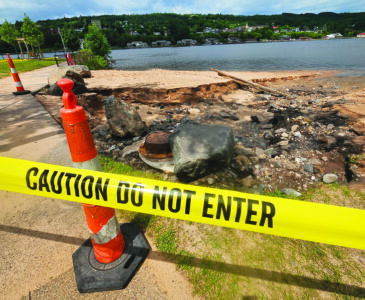Seventy-four are dead in Italian Hall Disaster
Editor’s note: This story is reprinted from the Daily Mining Gazette’s Dec. 24, 1913, edition with only spelling error changes.
Unknown Man Yells “Fire” at Christmas
Celebration and Children Rush to
Suffocation – – Effort to Escape
37 LITTLE GIRLS, 21
BOYS, 13 WOMEN,
AND 5 MEN DEAD
Man Who Cried “Fire” Supposed to
Be Drunk as He Came From Saloon on the Lower Floor
A holocaust unparalleled in the history of Michigan and ranking with the Iroquois theater fire and such castastrophy as the sinking of the Titanic in its frightful impor, occurred about five o’ clock this afternoon in the Italian Hall on north Seventh Street when approximately eighty lives, mostly children were lost.
An alarm was fire box forty-five contributed to the confusion with existed in the building at the time. There was however, in the Italian Hall building.
During the Christmas entertainment, arranged for by the Ladies Auxiliary of the Western Federation of Miners, a man, who has not been apprehended called “fire.” Instantly there was a rush for the narrow exits and at the bottom of the stairway, the little children were jammed into one solid mass, from which could emerge.
All efforts of those at hand to stop the onrush of the hundreds in the room were futile, and one by one the little lives were snuffed out.
More than seventy-five dead have been accounted for, and it is estimated there are from six to eight others who were removed to their homes by parents and friends before authorities arrived on the scene.
Practically every death was caused by suffocation, physicians assert, although many of the bodies mangled, none were so badly disfigured that identification would be impossible.
There were approximately 600 persons, about ninety-five per cent of whom were children, in the hall during the Christmas entertainment, which was arranged for by the women. Some estimates place the number at 700. Two versions of the accident are given by those in the hall.
Mrs. Annie Clemenc, president of the Auxiliary, stated immediately after the accident that she was on the stage together some of the other ladies who crowded toward the front of the building, really rushing to the platform. Those in charge of the distribution were doing their upmost to restrain the crowd and restore order when some man appeared at the door and called “fire.” Instantly there was a rush for the door. Efforts to stem the tied was ineffectual and the onrushing crowd poured through the door, into the narrow hallway and down the stairs, many of them to their deaths. The jam in the rear of the hall was almost as bas as in the stairway and as the excitement grew, the children, many of whom were infants of less than five years of age, fought and struggled to gain the street.
At the bottom of the stair the little ones were literally buried beneath a mass of humanity, a living tomb.
Mrs. Caesar of 421 Kearsarge Street, Laurium, states that she was in the hall and close to the man who called “fire.” She identifies him as a large man with a heavy beard. When the cry was first heard, she realized its danger instantly and reached up and grasped him by the shoulders in an effort to make him sit down. He escaped her grasp, however, and soon the cry of fire was taken up by others. The rush of the excited children towards the door was frightful to behold, Mrs Ceasar asserts. She herself succeeded in getting her little daughter out of the building to safety after semblance of order was restored.
Another woman who was in the building asserts the man who called “fire” spoke in two languages, first in English and then in Austrian. She asserts she heard the cry distinctly both times.
Others who were in the building assert that the call was heard from the stage as well as from the doorway, after the alarm first came.
Words are inadequate to describe the terrible scene in the Italian Hall immediately afterwards. The dead lay on every side, old men, women and little boys and girls, their bodies huddled into heaps and strewn out along the chairs on the floor, on the stage, in a little office adjoining the main hall and in a kitchen at the front of the hall and beneath the stage.
Hurried calls were sent out and soon every physician in town was on the scene. The living were separated from the dead and many who were thought to be dead recovered from the first shock and were the C&H hospital. The parents and relatives of the dead surged into the building and many of them took charge of the bodies of their loved ones before the authorities could take charge of the situation. The moaning of the injured mingled with the sobs of the bereaved parents, brothers, sisters and friends. Palled by the horror of the calamity, the officers quietly circulated here and there, helping where they could.
After the injured were cared for, the dead were gathered together and removed to the Red Jacket town hall where temporary provision was made to keep them until identification was made.
At the rear of the building, there is a narrow fire escape, but few were aware of its presence, and those who did seek to escape from the rear part of the building did so by jumping from the windows and the kitchen. Perhaps a dozen reached points of safety in this manner, the distance being so short that few were seriously injured.
Several hundred of the children escaped from the building over the fire escape, better order having apparently been maintained there than in the front part of the building.
The Italian hall is a comparatively new building, having been erected about five years ago. It was supposed to be well prepared for emergencies of this kind. The front stairway is about eight feet wide and leads up from an entrance perhaps ten feet from the doorway. At the top of the stairway is a small landing, perhaps eight feet wide by six feet long. Leading off from this is the main doorway. There is a room a little larger than the landing at the top of the stairway and connected with it by a narrow doorway. Here occurred almost as heavy a loss of life as at the foot of the stairway and in the stairway.
At the end of the building furtherest from the street is a spacious stage elevated from the main floorway about three feet. It was here that the distribution of Christmas presents. clothing, shoes, etc. was being made. Beneath the stage and considerably lower than the main floor is the kitchen, rather spacious in size. There were several deaths in this portion of the building, but but not as many as elsewhere. The fire escape at the rear of the building is a narrow one, but proved effectual in saving many lives.





